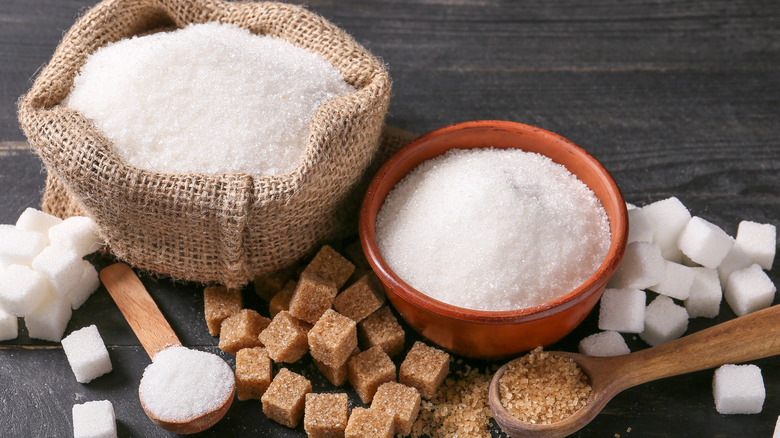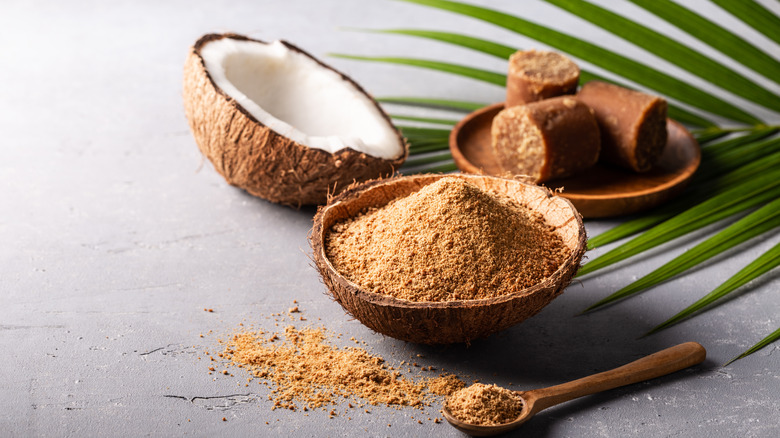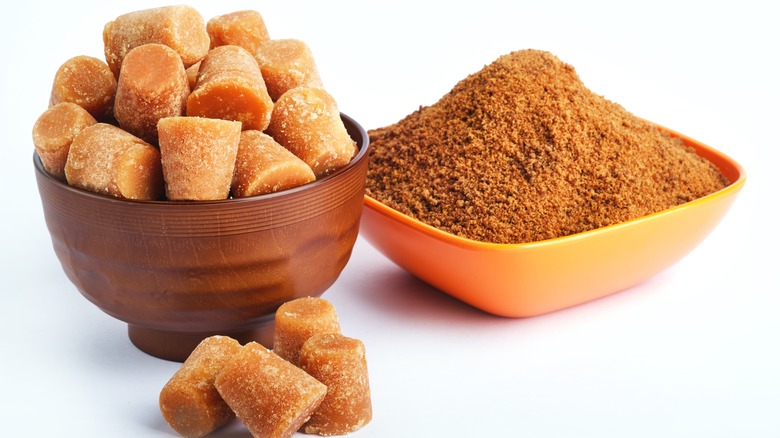Palm Sugar Vs. Jaggery: What's The Difference?
You may have stumbled across some unusual ingredients like palm sugar and jaggery in your grocery store's baking aisle and wondered what they are used for. Palm sugar and jaggery are two unique types of unrefined sugar that are most commonly found in eastern parts of the world such as India, Thailand, Vietnam, and parts of Africa. These two sugars may be less common in a Western diet, but they are excellent substitutes for regular refined sugar and offer a lot of complementary flavors to many popular dishes. Some dishes you may have even tried yourself — like pad thai!
There are many reasons to incorporate these sugars into your diet, perhaps as a replacement for refined sugars, or just for the sake of trying something new and expanding your palate. Both jaggery and palm sugar are derived from trees and, like regular sugar, can be used in both savory and sweet dishes. They can be purchased as pastes, solids, and sometimes even in liquid forms. However, these sugars usually have thicker and coarser granules than you may be used to seeing in refined white sugar.
What is palm sugar?
Palm sugar can be derived from both coconut trees and palm trees. It is often called coconut sugar when it's made from coconut trees, but despite the name difference, coconut sugar is still considered a type of palm sugar and is known to taste the same when compared side by side. One of the things that make palm sugar unique is a flavor that is often described as a mix of semi-sweet molasses and brown sugar, making it an easy substitute for recipes that require these ingredients. Palm sugar is popular in many Asian cuisines and found in traditional pad thai recipes. If you notice hints of sweetness in your next Thai dish, palm sugar has likely been the culprit to this delicious surprise.
If you are brave enough to try this unrefined sugar in some of your own recipes, you should be able to find it at your regular grocery store. If not, you can always purchase it online. If you are interested in experimenting with more than just palm sugar, it may be worth a shot to incorporate jaggery into one of your meals — or even try it in an authentic recipe from a local eatery.
What is jaggery?
Jaggery, while similar to palm sugar in profile, is not quite the same in terms of benefits and taste. Jaggery has a maple-like or caramel flavor that is even more similar to brown sugar. It can be most commonly found in firm cubes or crumbling granules — that are close to brown sugar in texture as well. What many people do not realize about this one-of-a-kind sugar is that it may have some added health benefits. Jaggery contains a mix of essential vitamins and minerals, allowing for slower digestion and less sucrose intake than traditional white sugar.
This type of sugar is most commonly found in Indian cuisines such as fig jam, banana pancakes, and orange cake. These tasty recipes use jaggery instead of sugar to give them a subtle caramel-like sweetness unmatched by refined sugar. Some Eastern cultures have even speculated that jaggery could be used in traditional and herbal medicines. While this sugar may seem random at first, the reason it may be a popular choice in Indian dishes is that 20-30% of the sugarcane production in India is focused specifically on jaggery. You may be surprised how much you like both the taste and the health benefits of jaggery or palm sugar!


